Guide to Mattress Sizes and Dimensions

Looking to save money on a mattress? Check out our roundup of the best Labor Day mattress deals of 2024!
Key Takeaways
- Standard mattress sizes are twin, twin XL, full, queen, king, and California king. The most popular mattress size is a queen.
- Non-standard mattress sizes provide a customized fit for some sleepers, but bedding for non-standard sizes can be hard to find.
- Consider factors like body size, sleep preferences, and room size to help choose a new mattress size.
Before considering the prices and features of the best mattresses, you need to know which size to shop for. Almost eight in 10 mattress shoppers surveyed by the Better Sleep Council knew the size they needed before looking for a mattress. [1]Mattress Shopper’s Buyer Journey. The Better Sleep Council. February 2020. Found on the internet at https://sleepproducts.org/wp-content/uploads/ISPA-Buyer-Journey.pdf Our Reviews Team created a guide to mattress sizes to help you confidently choose the best one, whether you are a side sleeper or looking for the best mattress for back pain. We researched standard and nonstandard bed sizes, interviewed experts, and consulted accessibility standards to inform our recommendations.
Mattress sizes and bed dimensions
| Mattress size name | Bed dimensions (length by width, in inches)* | Recommended sleeper maximum height (in feet and inches) See why | Recommended minimum room size (length by width, in feet)† See why |
|---|---|---|---|
| Small single | 75 x 30 | 5′ 9″ | 10 x 11 |
| Twin (Single) | 75 x 38 | 5′ 9″ | 10 x 11 |
| Twin XL (Twin long) | 80 x 38 | 6′ 2″ | 11 x 11 |
| Full (Double) | 75 x 53 | 5′ 9″ | 10 x 12 |
| Full XL | 80 x 53 | 6′ 2″ | 11 x 12 |
| Queen | 80 x 60 | 6′ 2″ | 11 x 13 |
| RV queen (Short queen) | 75 x 60 | 5′ 9″ | – |
| Olympic queen | 80 x 66 | 6′ 2″ | 11 x 14 |
| King (Standard king) | 80 x 76 | 6′ 2″ | 11 x 14 |
| RV king (Short king) | 80 x 72 | 6′ 2″ | – |
| California king | 84 x 72 | 6′ 6″ | 11 x 14 |
| Texas king | 98 x 80 | 7′ 8″ | 12 x 15 |
| Wyoming king | 84 x 84 | 6′ 6″ | 11 x 15 |
| Vermont king (Alberta king) | 96 x 96 | 7′ 6″ | 12 x 16 |
| Alaskan king | 108 x 108 | 8′ 6″ | 13 x 17 |
| Family | 80 x 120 | 6′ 2″ | 11 x 18 |
| Family XL | 84 x 144 | 6′ 2″ | 11 x 20 |
* Rounded to the nearest inch
† Rounded to the nearest foot

Many mattress companies suggest a bed size at least six inches longer than the tallest person sleeping on it. Putting weight on the edges of a mattress may not be supportive if the edges aren’t reinforced. The additional space can also account for people who may use one or multiple pillows, for example, to elevate their torso while in bed.

To keep our recommendations in line with accessibility guidelines and general home safety, we suggest room sizes with ample space around three sides of the bed to maneuver safely. The Americans with Disabilities Act (ADA) standard for accessible routes in living spaces requires at least 36 inches of clear floor space around a bed for a standard wheelchair to turn. [2]ADA.gov. 2010 ADA Standards for Accessible Design. Sept. 15, 2010. Found on the internet at https://www.ada.gov/law-and-regs/design-standards/2010-stds/#809 You can calculate the minimum room size for each mattress by adding 4 feet to the length and 8 feet to the width of the bed to account for things like bedroom furniture and storage.
Standard mattress sizes
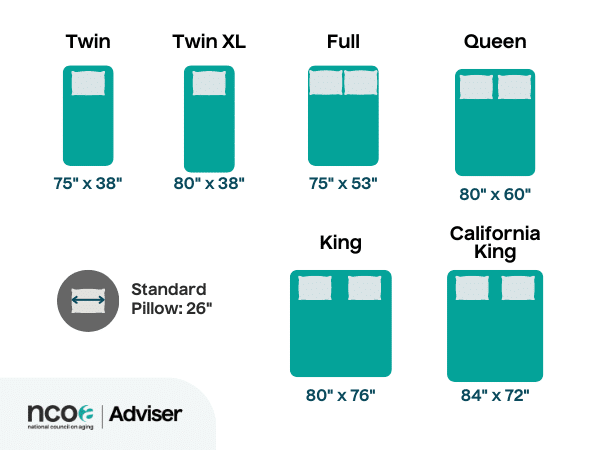
Most mattress manufacturers offer six standard sizes: twin, twin XL, full, queen, king, and California king. While the actual dimensions of these bed sizes aren’t set by law or regulation, the numbers we provide are the most common sizes available and are used by most major mattress retailers. The International Sleep Products Association (ISPA) currently advocates for the creation of guidelines for standard sizes so bedding manufacturers can work together to create frames, mattresses, and bed sheets that fit together. [3]International Sleep Products Association. Sleep Products Voluntary Dimensional Guideline for Bedding Products and Components. 2001.
Twin
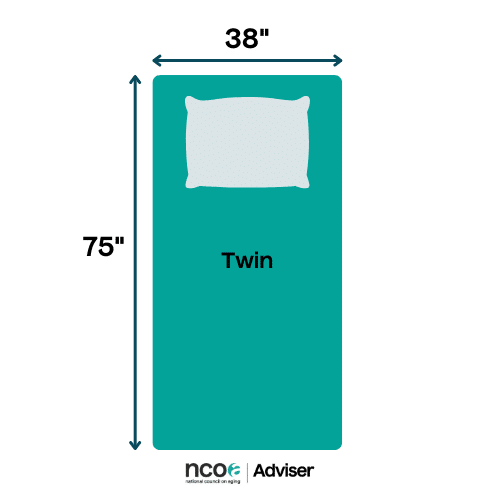
Length: 75 inches
Width: 38 inches
Best for: Single sleepers, people with smaller bodies, daybeds, bunk beds
Twin mattresses, also known as single mattresses, are common for single sleepers. It’s the most common size for daybeds and bunk beds. A twin mattress is the smallest standard mattress and may be too small for people with larger bodies. For example, someone 6 feet tall (72 inches) will only have 3 inches of space above their head if their feet rest at the foot of the bed.
Twin XL
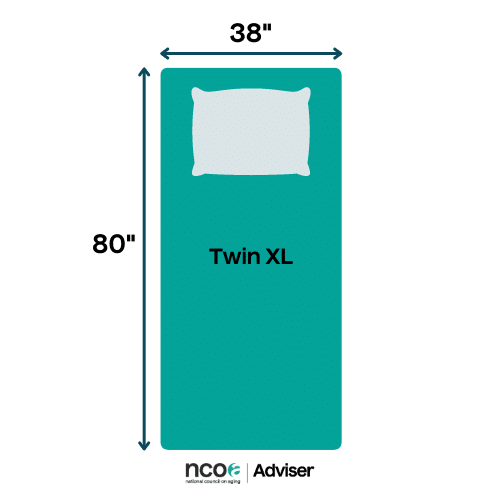
Length: 80 inches
Width: 38 inches
Best for: Single sleepers, split king beds
A twin XL (twin extra long), also known as a twin long, is 5 inches longer than a regular twin mattress. It’s also the same length (80 inches) as a standard queen and king mattress. The twin XL mattress is a common size for single sleepers and may be more comfortable than the standard twin for taller adults. Two twin XL mattresses can fit in a king or split king bed frame, which can be helpful for couples who share a king-size bed but have different firmness or support preferences.
Full
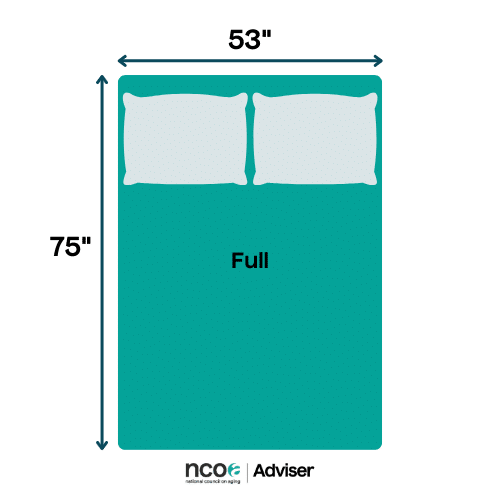
Length: 75 inches
Width: 53 inches
Best for: Single sleepers who prefer more space
A full mattress is also called a double bed. Despite the name, two adults may find this size a tight fit, depending on their body sizes and preferences. For reference, a full-size mattress can fit two standard pillows (26 inches in length each) across its width. Full-size mattresses are 15 inches wider than a twin. We recommend this size for single sleepers who like more room to stretch out or who change positions often throughout the night.
Queen

Length: 60 inches
Width: 80 inches
Best for: Couples sharing a bed, people with larger bodies, guest rooms
A queen mattress is the most popular size. Almost half of Americans who purchased a mattress in 2019 bought a queen size bed. [1]Mattress Shopper’s Buyer Journey. The Better Sleep Council. February 2020. Found on the internet at https://sleepproducts.org/wp-content/uploads/ISPA-Buyer-Journey.pdf It has enough space for two people sharing a bed, making it a good choice for guest rooms.
A queen mattress is 5 inches longer and 7 inches wider than a full-size bed. Because it is longer and wider, we recommend a queen-size mattress for people with larger bodies.
King

Length: 80 inches
Width: 76 inches
Best for: Couples sharing a bed who prefer more space, people with larger bodies
A king-size mattress is 16 inches wider than a queen. It’s a good option for couples sharing a bed who want more room to switch positions or stretch out. A king-size mattress is the same as two twin XL mattresses pushed together, so each person will have the same space as they would on a twin XL bed.
Individuals or couples with larger bodies may feel more comfortable with the extra space on a king rather than a queen mattress.
California king

Length: 72 inches
Width: 84 inches
Best for: Couples sharing a bed, people with larger bodies, people who prefer more legroom
A California king mattress is 4 inches narrower but 4 inches longer than a king mattress. The extra length of this size makes it our recommendation for people with larger bodies and taller individuals. We also recommend this for people who prefer more legroom compared to a twin XL, queen, and king.
A California king can comfortably fit people up to 6 feet, 6 inches tall.
Non-standard mattress dimensions
Manufacturers may also offer non-standard mattress sizes to fit your sleep needs. But, popular mattress brands don’t commonly make them, and finding bedding in stores that fit these mattresses may be a challenge. Variations of the twin, full, and queen sizes are called non-standard, while bed sizes larger than the California king size are considered oversized.
Small single

Length: 75 inches
Width: 30 inches
A small single mattress is the same length as a standard twin but 8 inches narrower. This size is well-suited for people with smaller bodies. Small single mattresses are common for rollaway, trundle ⓘA bed that rolls under a larger bed., and single guest beds. [3]International Sleep Products Association. Sleep Products Voluntary Dimensional Guideline for Bedding Products and Components. 2001.
Full XL
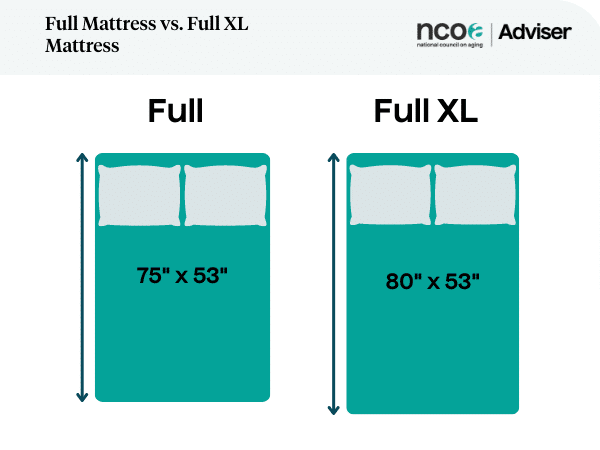
Length: 80 inches
Width: 53 inches
A full XL (full extra long), similar to a twin XL, is 5 inches longer than a full-size mattress. We recommend the full XL for single sleepers who prefer more legroom or single sleepers with larger bodies.
Olympic queen
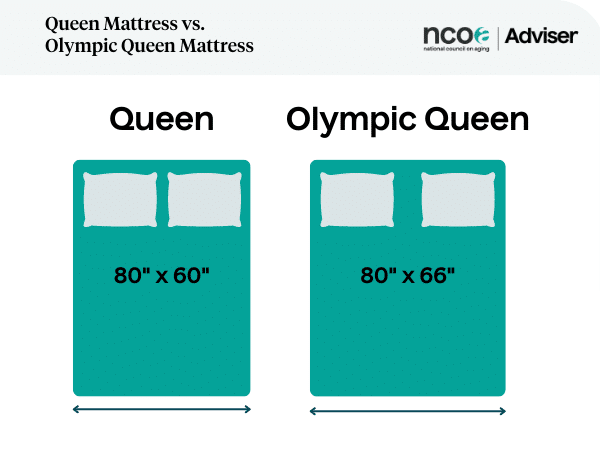
Length: 80 inches
Width: 66 inches
The Olympic queen is 6 inches wider than a queen-size mattress. It’s not as wide as a king (76 inches wide) or California king (72 inches wide), but it’s a good in-between-size option for couples sharing a bed.
RV sizes
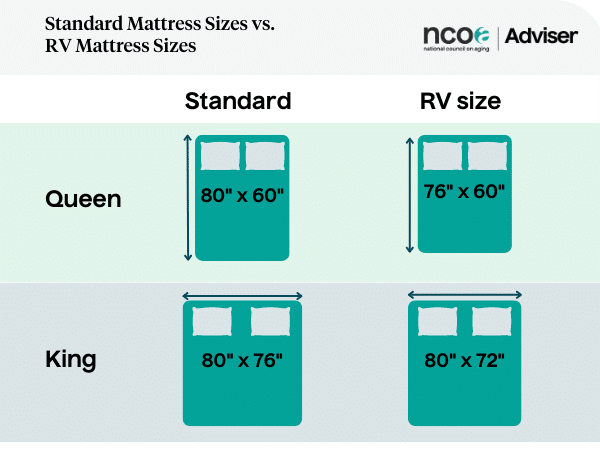
RV sizes are slightly smaller than their respective standard sizes in order to fit into recreational vehicles (RVs). RV mattress sizes can vary between manufacturers. Below are some common bed dimensions we found for RV queen and king mattresses.
RV queen
RV queen length: 76 inches
RV queen width: 60 inches
RV queen mattresses (also called short queen) are 5 inches shorter than a queen mattress.
RV king
RV king length: 80 inches
RV king width: 72 inches
RV king mattresses (also called short king) are 4 inches narrower than a king mattress.
Oversized mattresses (Nonstandard king sizes)
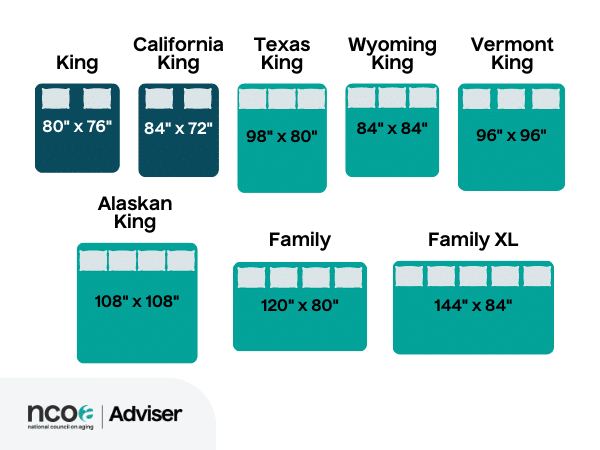
Oversized mattresses are larger than king and California king mattresses. These mattresses are 7 feet or more at their longest side, requiring large rooms to accommodate them. Here are a few oversized mattress options.
Oversized mattresses and bed dimensions
| Mattress size name | Bed dimensions (length by width, in inches) | Longest side (in inches) | Width in standard-sized pillows* |
|---|---|---|---|
| Texas king | 98 x 80 | 98 | 3 |
| Wyoming king | 84 x 84 | 84 | 3 |
| Vermont king (Alberta king) | 96 x 96 | 96 | 3 |
| Alaskan king | 108 x 108 | 108 | 4 |
| Family | 80 x 120 | 120 | 4 |
| Family XL | 84 x 144 | 144 | 5 |
* Rounded to the nearest whole number
The Texas, Wyoming, and Vermont king sizes can all fit three standard pillows across their width. The Texas king is 14 inches longer than a California king, which is great for people with taller bodies.
The Wyoming king and Vermont king (also known as the Alberta king) mattresses are both square. The Wyoming king is 7 feet on each side, and the Vermont king is 8 feet on each side.
The Alaskan king and family mattresses can both fit four standard pillows across their widths. The Alaskan king is a square, and measures 9 feet on each side. The family size has the same length as a king size but is 10 feet wide. A family-size mattress is the same size as two queen beds put side-by-side.
The family XL mattress is 4 inches longer than the family size and is 12 feet wide. It’s the size of two California king beds put side-by-side and can fit five standard pillows across its width.
How to choose a mattress size
The best mattress size for you can depend on your body, room size, sleeping partners, medical conditions, and other personal preferences. Here are a few factors to consider when choosing a mattress size:
Body size
Your whole body should comfortably fit on your mattress without reaching the edges of the bed. Your height is one measurement to keep in mind when choosing a mattress. The average U.S. adult male, with a height of 5 feet, 9 inches, can fit on the shortest standard mattress sizes (twin and full-size). [4]Centers for Disease Control and Prevention. Body Measurements. Sept. 10, 2021. Found on the internet at https://www.cdc.gov/nchs/fastats/body-measurements.htm

Body size is more important than body weight when choosing a mattress. A mattress’ weight capacity largely depends on its construction and firmness rather than size. The weight capacity of a mattress can vary from model to model. For example, a Saatva Classic mattress in any size supports up to 300 pounds per side, whereas any-sized Saatva HD mattress can support higher weights, up to 500 pounds per side.
- Best for individuals with smaller bodies: twin or full
- Best for individuals with larger bodies: queen or larger
- Best for people who are six feet or taller: California king or larger
- Best for couples: king or larger
Room size
Anyone moving through your bedroom should be able to do so safely with a correctly sized mattress. For example, a king mattress may be comfortable for couples who enjoy more space, but if their bedroom is smaller than 11 feet by 14 feet, it may limit their ability to move around easily.
For both safety and accessibility, ADA standards recommend at least 36 inches (3 feet) of clear and open space around the bed. [2]ADA.gov. 2010 ADA Standards for Accessible Design. Sept. 15, 2010. Found on the internet at https://www.ada.gov/law-and-regs/design-standards/2010-stds/#809 This is one of the reasons we recommend room sizes with at least 4 feet of space around three sides of the bed.
- Best for individuals in small bedrooms: twin or twin XL
- Best for couples in small bedrooms: full or queen
- Best for RVs: RV queen or RV king
Mobility
People with limited mobility or who often change positions during sleep may have special considerations when shopping for a mattress. According to Nicole Hernandez, DPT, if a person has limited mobility or strength, they may find it difficult to maneuver toward the edge of a large bed if they’re starting from the center. But a small bed may not suit those who change positions often or risk rolling off the bed. She recommended that individuals and caregivers consider safety and sleep patterns when determining an appropriate mattress size.
- Best for people who require mobility assistance: twin or twin XL
- Best for people who are at risk of rolling off a bed: queen or larger
Medical conditions
Your sleep can impact your health, but your health concerns can also affect the amount of space you need for a good night’s sleep. We talked with a sleep specialist to better understand how medical conditions can impact your choice of mattress size. Valerie Cacho, MD, a sleep specialist in Ewa Beach, Hawaii, shared that people with restless leg syndrome (RLS) may find it more comfortable to have a larger bed because symptoms of RLS get better with movement.
She added that people with REM behavior disorder, a condition more commonly found in older adults, may need more bed space. REM behavior disorder is a condition where people “act out” their dreams during the REM stage of sleep, resulting in more movement in bed. [5]Trotti, L. REM Sleep Behaviour Disorder in Older Individuals. Drugs and Aging. 2010. Found on the internet at https://link.springer.com/article/10.2165/11536260-000000000-00000
Studies have shown people who have obstructive sleep apnea or acid reflux may sleep better when they elevate their torso while sleeping. [6]Fabricio de Barros Souza, FJ, et al. The Influence of Head-of-Bed Elevation in Patients with Obstructive Sleep Apnea. Sleep and Breathing. June 24, 2017. Found on the internet at https://link.springer.com/article/10.1007/s11325-017-1524-3 [7]Albarqouni, L, et al. Head of Bed Elevation to Relieve Gastroesophageal Reflux Symptoms: A Systematic Review. BMC Family Practice. Jan. 19, 2021. Found on the internet at https://bmcprimcare.biomedcentral.com/articles/10.1186/s12875-021-01369-0 They may require more bed space if they’re using a wedge pillow or multiple pillows. Alternatively, these individuals may consider an adjustable bed to elevate their upper-body position. Split king adjustable beds allow couples sharing a bed to sleep in two separate positions customized to their comfort.
- Best for individuals with a high level of movement in bed: full or larger
- Best for people who sleep with pillows elevating their torso: full XL or larger
- Best for split king adjustable beds: two twin XL mattresses
Sharing a bed
When deciding on a bed size for more than one person, you’ll need to consider multiple sizes, needs, and preferences. Here are a few questions for partners to consider: How many people will share the bed? Do you prefer to stay close or have your own space? Do you allow one or more pets on the bed?
Partners of people with RLS, REM behavior disorder, or obstructive sleep apnea may consider a larger bed for more personal space and a better night’s sleep. If you share a bed with a partner who tends to snore or get out of bed often—to go to the restroom, for example— consider a larger bed so that you’re less likely to be disturbed by the extra noise or motion.
- Best for couples who prefer to stay close: queen
- Best for couples who need more personal space: king
- Best for people who prefer more legroom: California king
- Best for couples sharing a bed with pets: king
- Best for families sharing a bed: family
Comfort
Comfort is a big factor in determining which mattress size is best for you. Consider how your sleeping position affects how much space you take up. For example, a person who feels comfortable sleeping in a curled-up position may take up less space than someone who feels better sleeping with their arms and legs stretched out. Some people sleep hot and may need more space from their partner to regulate their body temperature.
Hernandez shared that using multiple pillows can support a more comfortable sleep position. For example, someone with back pain may feel relief by placing pillows under their knees (while sleeping on their back) or between their knees (while sleeping on their side). These pillows can take up space and require a larger bed to accommodate them.
- Best for individuals who prefer more space: full or larger
- Best for individuals who sleep with pain-relieving pillows: full
- Best for couples who sleep with pain-relieving pillows: king
- Best for couples with a partner who sleeps hot: king
Price and value
The average cost of a mattress can vary significantly based on several factors, with size and materials being two of the most prominent.
For example, foam and innerspring queen-sized mattresses typically cost $700 to $1,200, while hybrid and latex queen-sized mattresses usually cost $1,500 to $2,200.
Additional considerations, such as brand reputation and features like pressure relief and temperature control, can also influence the cost.
Bottom line
Many factors go into choosing a mattress size that’s best for you. The six standard mattress sizes are readily available and provide a variety of choices for different sleep preferences. Twin, twin XL, and full mattresses are commonly recommended for one person, whereas queen, king, and California king sizes tend to be better suited for couples sharing a bed.
Nonstandard sizes fit specific furniture, like trundle beds, but most require custom bedding and furniture. These can be good options for people with larger bodies or who share a bed and need more space for a good night’s sleep.

Frequently asked questions
The size of your mattress can affect sleep quality. Factors such as sharing a bed with a partner, your body size, ideal sleep temperature, medical conditions, and sleep position can affect which mattress size best helps you get a good night’s sleep.
Standard mattress sizes are twin, twin XL, full, queen, king, and California king. Non-standard and oversized mattress sizes include small single, full XL, Olympic queen, RV king, and Wyoming king, among others.
Depending on the size and sleeping preferences of the people sharing the bed, we recommend looking for a king-size or larger mattress for more than two people. A Texas king can fit three standard pillows across its width.
A full-size mattress is 53 inches wide and 75 inches long.
A full-size is 15 inches wider than a twin mattress. They are both 75 inches long. For scale, you can fit two standard pillows across a full-size mattress.
The only difference between a queen bed and a king bed is the size. Queen beds are typically 60 inches wide and 80 inches long. A king bed is larger, measuring around 76 inches wide and 80 inches long.
Have questions about this review? Email us at reviewsteam@ncoa.org.
Sources
- Mattress Shopper’s Buyer Journey. The Better Sleep Council. February 2020. Found on the internet at https://sleepproducts.org/wp-content/uploads/ISPA-Buyer-Journey.pdf
- ADA.gov. 2010 ADA Standards for Accessible Design. Sept. 15, 2010. Found on the internet at https://www.ada.gov/law-and-regs/design-standards/2010-stds/#809
- International Sleep Products Association. Sleep Products Voluntary Dimensional Guideline for Bedding Products and Components. 2001.
- Centers for Disease Control and Prevention. Body Measurements. Sept. 10, 2021. Found on the internet at https://www.cdc.gov/nchs/fastats/body-measurements.htm
- Trotti, L. REM Sleep Behaviour Disorder in Older Individuals. Drugs and Aging. 2010. Found on the internet at https://link.springer.com/article/10.2165/11536260-000000000-00000
- Fabricio de Barros Souza, FJ, et al. The Influence of Head-of-Bed Elevation in Patients with Obstructive Sleep Apnea. Sleep and Breathing. June 24, 2017. Found on the internet at https://link.springer.com/article/10.1007/s11325-017-1524-3
- Albarqouni, L, et al. Head of Bed Elevation to Relieve Gastroesophageal Reflux Symptoms: A Systematic Review. BMC Family Practice. Jan. 19, 2021. Found on the internet at https://bmcprimcare.biomedcentral.com/articles/10.1186/s12875-021-01369-0

